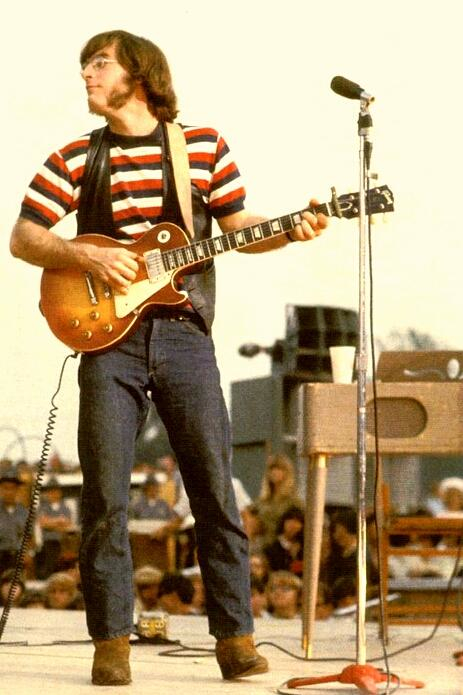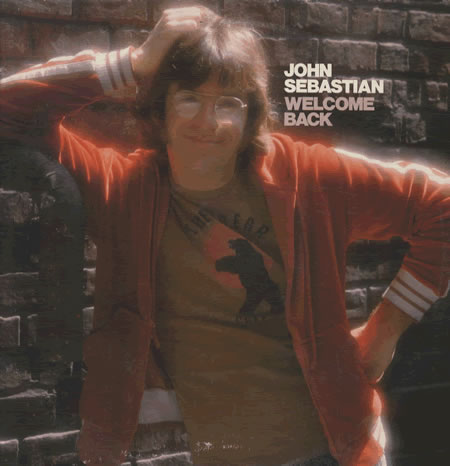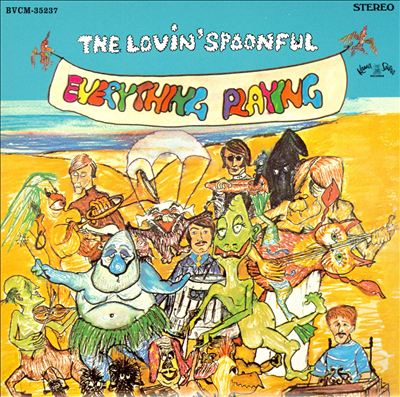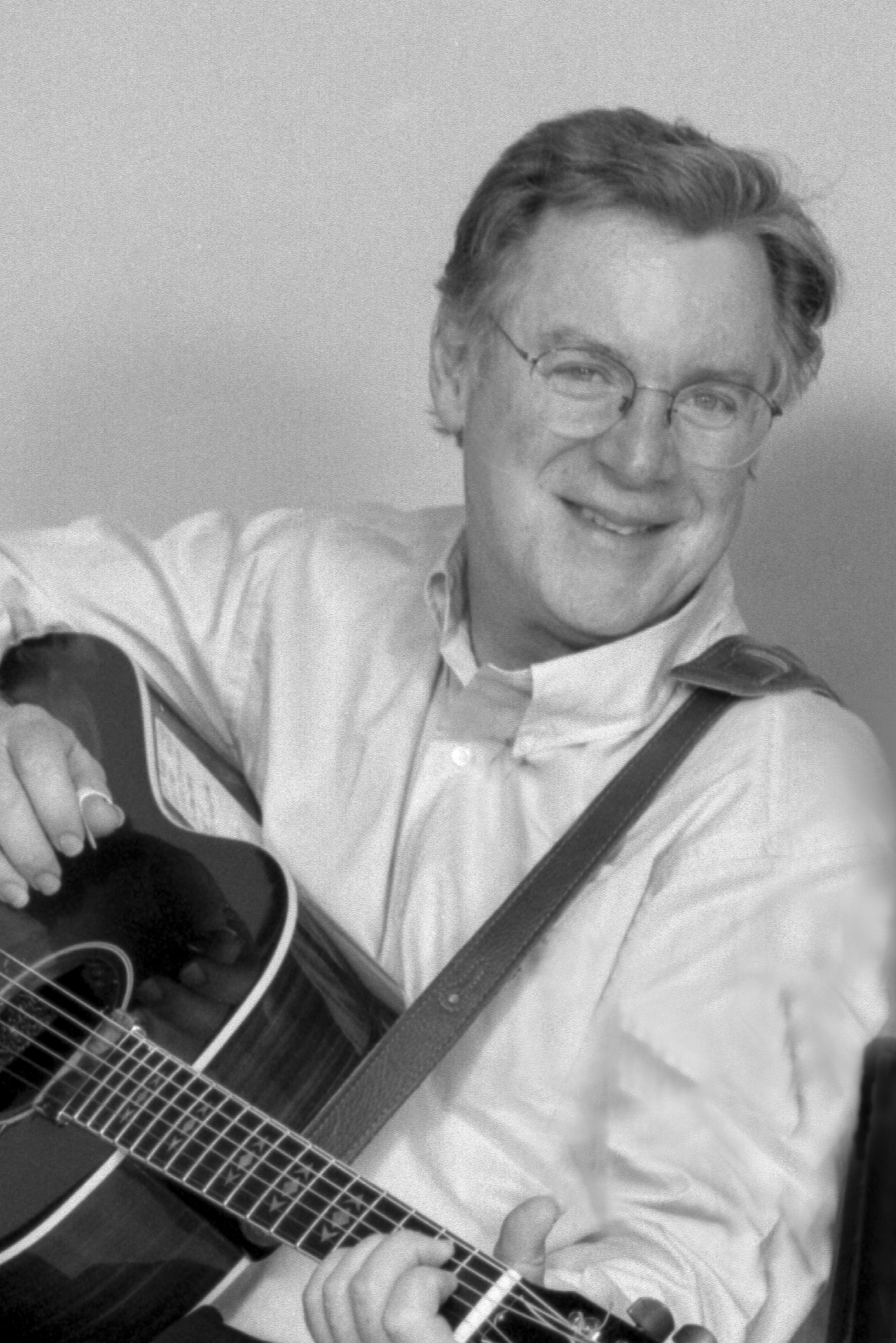We waited to see John Sebastian in a small club with dinner seating. The room was not crowded, not as packed as it should have been anyway; a few seats at tables right up front were even empty. Out the window the sun was going down. Beyond the relentless friendliness of our server, Gina, whose life story I’d already learned, I had no idea what to expect from this night. I was sitting with my boyfriend, Matt, and we were looking at the 45s we’d just bought at a record store on our way to the show. I had scored an Everything Playing LP, the last album Sebastian made with the Lovin’ Spoonful, in 1967, but I didn’t show it to Gina.
“I can tell you’re awesome,” she was saying, “Because you like your steak medium rare. I mean I’m never rude to people who order it well-done, but I’m just, like, ‘oh, okay.'” Twirling her pencil between her fingers. “You have to just be polite.”
~
I was born in Greenwich Village and I’m proud of that — I feel a wistful twinge when I pass my childhood home on 7th Avenue and Grove Street. My parents moved there in 1976; my mom is from the Netherlands and my dad is from Puerto Rico. I love animals and could be around them 24 hours a day. I have affection for people, but I take them in smaller doses. I really prefer my own company most of the time. I love New York– hearing voices from the courtyard of the Marshall Chess Club; curling up with a book and a slice of pizza in Father Demo Square. There’s an old laundromat on West 4th Street that I like to just look at, thinking Don’t ever change.
I went to college here after boarding school. While my life has been quite happy, I sense something of the underdog about myself, something sort of pathetic and accursed. Like Bert from Sesame Street, I love my little items: records, nature guides, figurines. I am obsessed with the Simpsons.
And I love John Sebastian.
I mean John B. Sebastian, the songwriter who fronted the Lovin’ Spoonful, then went solo, did Woodstock, wrote one of the greatest TV themes ever, and since then has been finding his way back to jug band and blues, where his heart has always lain. Yes, him! I love him. In the ostentatious world of Sixties pop, Sebastian’s songs stand apart by being clever and goofy, often sweet, always exquisitely human. I recite Spoonful lyrics in my head like poems (I really do this), and they never fail to bring a smile — sometimes a little sniffle too. Consider the second verse of “Younger Generation,” in which an expectant father frets about what kind of person his son will be in a changing world:
And then I’ll know that all I’ve learned my kid assumes
And all my deepest worries must be his cartoons
And still I’ll try to tell him all the things I’ve done
Relating to what he can do when he becomes a man
And still he’ll stick his fingers in the fan.
[embedyt]http://www.youtube.com/watch?v=XnsB4Ck__OE[/embedyt]
~
As he took the stage now, Sebastian began by picking his way through “I’m Satisfied” — a song by bluesman Mississippi John Hurt, one of his idols, which has become a favorite in his own repertoire. Next, he assessed the audience. “I see a lot of old furry guys out there,” he teased, “who are probably expecting a certain… body of work.” Meaning that these guys were hoping tonight might transport them back to a time when they were less old and less furry, exactly fifty years ago in fact, when the Lovin’ Spoonful were on the radio and ruled their lives.
It’s probably best not to analyze my Sixties-music thing too deeply, but maybe I like it because it makes me feel young: amid these sixtysomethings eating their salads and golf-clapping, I was “only” 37, in on the joke but not the butt of it, able to rise above all this old-centric gallows humor. Still, at 37 I was glad to be at a concert where I could sit, put my bag down, get served dinner and wine (though the dinner, full disclosure, was a plate of nachos). My contact lenses were acting funny, so I kept squinting and Matt was asking if I was all right. Also, the two of us were five years into our stable, loving relationship, holding hands at the table. A quarter of my life had definitely passed, even if the half was still some distance away.
“My mom’s side are farmers, you know?” Gina said as she placed our food in front of us. “My mom grew up in a place where the cattle walked around outside their window. So that’s why I can tell you, you’re gonna like this.”
~
I knew I would love John Sebastian’s set no matter what. Not the greatest mindset for a critic, but who cares? Seeing and hearing him play, though, inspired more than just love: he was commanding and fascinating, even in that so-so venue (“You’ve gotta love a spirited kitchen!” he said over the noise of clanging pots), or especially in it. Call it awe. The first Spoonful song he played was “Do You Believe In Magic,” but how do you properly convey that jangly hit’s message–about the power of music to fill a life with joy–without drums or autoharp or bass or anything, save a guitar and a voice that’s showing its age? Well, you can’t.
John has an instructional video that demonstrates a handful of the most famous Spoonful songs as a guitar tutorial. I’ve watched some of it, not to learn the songs but to hear him discuss them. He’s a great teacher. And there was an element of instruction in the show, too, as he wove stories and illustrated them musically before launching into each tune. Before “Magic,” for instance, he played the chord progression for “Heat Wave” by Martha and the Vandellas — slowly, explaining that he used to listen to it on the jukebox. You heard the resemblance, so that when he sped the chords up and they turned into his band’s first single it felt not exactly like magic, more like destiny. Thereafter it wasn’t hard to imagine each song coming out of a young furry guy, with chestnut hair and a face full of muttonchops, dressed in a striped T-shirt.
~
John B. Sebastian was a West Village kid, though he spent a stretch of his boyhood in Rome. His father, John Sebastian, née Giovanni Puglese, played classical harmonica, recording for RCA Victor, Cadence, and other labels. They were a showbiz family. John’s mother, Jane, wrote radio scripts and worked for Carnegie Hall; actress Vivian Vance (TV’s Ethel Mertz) was his godmother. Once grown John was in Washington Square, a good place at that time to depart from gentrified tastes and delve into roots music, including blues. He knew Mississippi John Hurt personally, whose tune “Coffee Blues” (“I love my baby / By the lovin’ spoonful”) would provide his band with its name. It was in the Village that he met his friend Cass Elliot, who introduced him to Canadian guitarist Zal Yanovsky at a party where they watched the Beatles on Ed Sullivan. John and Zal fell in with bassist Steve Boone and drummer Joe Butler, both rockers who hailed from Long Island. And the Spoonful was born, eventually creating a staggering output of six albums in just over two years. Their only song to reach #1 was “Summer in the City,” one of rock music’s most beloved records.
[embedyt]http://www.youtube.com/watch?v=U5bUmx-hk-c[/embedyt]
The Spoonful enjoyed six more Top Ten hits, well-known to radio listeners for their happy, romp-worthy pop sound. Unlike many groups of the era, they played all their own instruments, with Sebastian contributing harmonica, autoharp, banjo, piano, and (usually) rhythm guitar that complemented Zally’s flamboyant leads.
The band’s music was a stew of diverse influences like rock ‘n’ roll, folk, jug band, and country, blended in an amateurish way that nevertheless ends up sounding confident and complete; it stands the test of time remarkably well.
At the heart of the Spoonful’s appeal, however, is John’s skill as a lyricist. He writes romantic and funny equally well, able to cut the treacle with an astute turn of phrase or a cute gimmick, like the slant rhymes in “Darlin’ Companion.”
Darlin’ companion, come on and give me understandin’
And let me be your champion: a hand to hold your pretty hand in
Darlin’ companion, now you know you’ll never be abandoned.
Word-stuffed comedy epics like “Pow!” betray his fanaticism for language:
I was standing in an artsy-fartsy uptown restaurant a few frozen dinners ago,
When I stumbled on a waiter full of crêpe suzettes and I ran out the door flambeau.
But there’s also a stunning tenderness to “Darling Be Home Soon,” the best of his love songs: a boy waits for his girlfriend to come home from work, understanding that he’s really been waiting for her all his life. Even as it talks of a love affair in bloom, a feeling of insecurity pervades it. Phrases glitter with detail, but lyrics never sound forced. The music always matches.
[embedyt]http://www.youtube.com/watch?v=fXjzOpz4Cyw[/embedyt]
A quarter of my life is almost past
I think I’ve come to see myself at last
And I see that the time spent confused
Was the time that I spent without you.
The rest of the band were boisterous in their playing (and, by all accounts, their personalities); Sebastian, the leader, seemed laid-back and subtle, with a quiet singing voice and feather-light fingers when he’d occasionally play lead guitar, as on “Did You Ever Have to Make Up Your Mind.” For his solo work too, “gentle” tends to be the watchword, evoking the image of a dude wearing glasses and tie-dye, slouched over a guitar or cuddling an autoharp, his face lit up in a beatific smile. But there are plenty of moments when John gets wild–particularly in harmonica solos, but also in the fierce vocal on “Summer in the City” and his many slapstick lyrics. (In Lovin’ Spoonful songs you’ll find John throwing up, falling on his face, drowning, and in various other kinds of bodily trouble.) Plus, I’ve always admired how much he used the word “fuck” in his stage patter at Woodstock and elsewhere. Even now, performing for us, he showed flashes of rebellion that he wore well, chiding audience members for talking during his monologue or for trying to record him with a phone. “Sure, you could play it back later and watch it,” he told the thwarted videographer. “But I’d be so much smaller then.”
~
“Can I take these drinks for you guys? Do you want to try a cocktail, or…?” Gina appeared and piped up again, this time mid-show, while John Sebastian was starting to play “Lovin’ You.”
“No, we’re fine,” I told her, whispering, resisting the urge to shoo her away with my hand. “I guess we’ll take the check.”
“OK! Thanks so, so much,” she said at normal volume. “I had a great time serving you, and I really hope to see you around sometime!”
John sang: Now the reasons never send me runnin’ round, Fingers on my forehead cool and calm me down.
“I work at Café Resto during the day!” said Gina. I wondered if we were the only patrons who hadn’t been mean to her; I hoped not. She went away as I tried to remember how the first part of “Lovin’ You” had gone.
I remembered something else: the live album Real Live John Sebastian, released by Reprise and the joke company “Cheapo-Cheapo Productions” after MGM had put out another live LP illegally. Real Live was recorded in 1970 and also included “Lovin’ You.” It had other things in common, too, with the set we were hearing — not that John did all the same songs; actually, it was similar in that he did so many different songs. On Real Live, he gamely lays into “In the Still Of the Night” and “Ballad of a Teenage Queen,” the latter after an audience member requests it; for us he interpreted the Everly Brothers’ “Walk Right Back” as a delicate instrumental after explaining that it had been a lullaby for one of his boys. (There I was thinking he would play “Younger Generation” after that story. Shows what I know.) And in both cases he exhorted the crowd to participate, on the record even teaching them the words to “Fishin’ Blues” so they could sing along. In many of his live recordings you hear him stop, listening for a crowd’s a cappella response — then ask for it, if it isn’t forthcoming. From us he demanded backup; let me say, being in a chorus of backing vocals to “You Didn’t Have to Be So Nice,” then a whistling section for “Daydream,” seems corny until you do it.
~
After he left the Lovin’ Spoonful in 1968, Sebastian began spending most of his time in California, where he nurtured a solo career in the fertile Laurel Canyon scene. At around this time John moved into a tent at a commune called The Farm, where he met Catherine, who remains his wife today. His appearance at Woodstock was unplanned; in the festival film he’s overwhelmed, stoned and fumbling for his words at first, then recovering beautifully in a performance that’s touching to watch for all but the most vehement of hippie-haters.
John B. Sebastian, a gem made with help from a dozen famous friends, achieved only modest success (due largely to the unscrupulous nature, again, of MGM) and no subsequent efforts really clicked on the level of the Lovin’ Spoonful until he was tapped to write the theme song for a sitcom named Welcome Back, Kotter. Warm and cutesy and oh-so-Seventies, “Welcome Back” became so popular, Sebastian recorded a long version and made it the title track for an aptly-named album.
The Eighties saw Sebastian making music for TV and movies, most of them for children; by the time Tar Beach came out in 1993, he was settling into the elder-statesman role he occupies now. He lives in Woodstock, New York, and there seems to be no better town for him — surrounded by music and musicians, constantly playing. Watching him, however, gave me a strong sense that though he’d seen it all, done it all, it came down to just this: one person and a guitar.
It’s comforting when people don’t change too much. The John Sebastian we saw this summer was fundamentally the one who thought up “Do You Believe in Magic” — a fine guitar player, benevolent, gregarious, wry, full of himself. His opening act, the blues duo Paul Rishell and Annie Raines, accompanied their friend on a few songs, but mostly it was just him, switching between two guitars, telling stories, not needing to show off. In recent years some have been disappointed in John’s vocal quality; while it was evident that he no longer possesses the voice that sang “The Room Nobody Lives In,” he still sounded like himself, just singing lower, with a gravelly touch befitting a 71-year-old man. John is now the same age that John Hurt was back when he discovered him, and seems to acknowledge this; he even played “Coffee Blues” (and half the audience even recognized it). To say more would be to give away too many autobiographical secrets that he evidently guards, saving them for shows like this.
~
In general, I hate being around celebrities. Knowing who one is makes me feel vulnerable, naked–like at any moment I might point at them and scream whatever their famous catchphrase is, unable to help myself. Instead, I look away and try to leave the area as fast as I can, thereby giving both of us back our dignity. Since buying the tickets, I’d had a month to prepare for meeting John after the show, if I was really going to do it — but I never thought about what I might say. So I guess I choked. I could have used any of the following openers, but didn’t:
1. I have a radio show, and I play your songs on it all the time.
2. I run a Twitter account for Lovin’ Spoonful fans. It’s called @SpoonfulCats.
3. I have a degree in screenwriting. Can I write you a biopic?
4. I know all the words to “Jug Band Music.”
5. My stepfather, Thomas, met you at The Farm when he visited L.A. in 1970. He says a friend of yours still owes him a pair of tie-dyed pants.
After the fact, I would recall the others in the line, from the ones who just mutely handed over stacks of albums to be autographed to the ones who gushed about seeing a Lovin’ Spoonful show back in ’66 on a first date. A shy, thrilled woman in a pink dress posed demurely beside John for a photo snapped by her husband, hovering close but careful not to touch.
When my turn came and I was up close to him, all I could muster was “Thank you.” He sat up straight at the table, looking a little weary yet dapper in a nice button down shirt; pink-faced, with smallish grey sideburns shaved into points. I thanked him. I must have said his songs meant a lot to me, but I don’t recall actually saying “Your songs mean a lot to me.” I guess he said thank you too, or you’re welcome, or something.
Then I told him, “I’m from Greenwich Village.”
He said, “Where do you live?”
“Well, now I live in Brooklyn,” I replied.
He smiled. “Ah, well, Brooklyn’s where everyone went who used to live in the Village, right?”
I said yes — but explained that when I was at NYU, there were a lucky couple of years when I stayed in my childhood home on Grove Street. My folks were divorced and my father was living in Puerto Rico.
“You see? A divorce can work out real well for kids, in some ways,” said John Sebastian. (His own parents, somewhat ahead of their time for New York couples, divorced when he was 13.)
By then, the people behind me in line were getting grumpy, so I produced my newly-bought copy of Everything Playing for John to autograph. “Whoa, where’d you find this?” he said.
I started to tell him about the record store, but he wasn’t really listening, and then I left the line and that was it. Matt decided to go talk to him too; when I asked him how it went, he said, “Oh, I don’t think he heard what I was saying. But he was very cool about it.”
I’ll be thinking about that meeting for years. Should I have asked for more? The better question might be, What more would I have the right to ask for? Celebrities, especially the ones we love, owe us nothing. Rather, it’s we who owe them — for the lifetime of enjoyment they give us normal people, just by being themselves. In the case of musicians, they open their hearts to us through their songs, and we respond by stampeding into their personal lives, trying to make them know us, something they never asked for. I was reluctant to meet John that night because he’s one of my favorite people, and I’d rather he not know me at all than remember me as someone who bothered him.
Yet, I’ll cherish the experience. The whole thing. (If I’m such a purist about leaving rock stars alone, why am I keeping my signed Everything Playing LP? Shouldn’t I just toss it in the garbage?) The way it felt to share the room with him, the way my contacts stopped itching because my eyes leaked tears when he closed with “Darling Be Home Soon.” That’s why I was there, and boy was it worth it. The rest of the fans and me dispensed with, John B. Sebastian adjourned to his dressing room behind the bar. We waited, but once he emerged wearing a snazzy Panama hat and slipped out into the night, we let him go.








Did John ever tell you what specific year or years he went to school in Rome? I attended the same school—Notre Dame International—from Fall of ’63 to June ’69. None of knew he had attended. I’ll query the old timers at the Notre Dame FB page; maybe some of them will recall. Thanks.
Bill Wyman also went there for a while but I was unaware of that until the Internet came along.